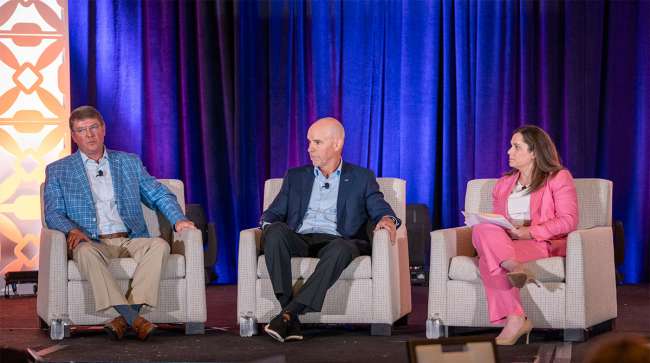Senior Reporter
Expert Panel Critical of Regulatory Push for Electric Trucks

[Stay on top of transportation news: Get TTNews in your inbox.]
SAN ANTONIO — The road ahead for fleets to convert to electric trucks is an expensive and challenging one beset by regulatory and operational hurdles, a panel of trucking experts told executives attending a session at American Trucking Associations’ 2024 Mid-Year Management Session.
“We’re all looking for efficiency — what’s going to be the most efficient solution, the most cost effective,” said panelist Robert Sanchez, CEO of Ryder System Inc., whose company leases equipment to motor carriers. He said his customers are looking for cost data, reliability and simplicity when weighing the possibility of adding EVs to their operations.
“None of those are what we’re getting with the technology that is out there right now,” he said.
Those concerns were laid out in a study Ryder published earlier this month on the costs of converting to electric trucks. The findings demonstrated that — based on representative network loads and routes from Ryder’s dedicated fleet operations in today’s market and other factors — the annual total cost to transport by electric vehicles versus diesel is estimated to increase across the board ranging from up to 5% for a light-duty transit van to as much as 114% for a heavy-duty tractor, depending on the geographic area. For a mixed fleet of 25 light-, medium- and heavy-duty vehicles, the analysis showed an increased cost of up to 67% for an all-electric fleet. The study also revealed “significant driver time lost” due to charging issues, Sanchez added.
Electric Vehicle Total Cost to Transport Analysis
All of these challenges will require broad industry commitment to finding workable solutions, he stressed.
“My hope is on — given ingenuity — that there will be a breakthrough at some point where we will see a cost-effective solution,” Sanchez said. “Unfortunately, we’re not there yet.”
Regulatory benchmarks only tighten the pressure, said Jacqueline Gelb, ATA’s vice president of energy and environmental affairs.
“Our industry is moving through the most active regulatory environment that we have ever experienced,” she said. “The rules of engagement have changed for us.”
Those rules include timelines on federal and state levels that the head of an industry action group views as unrealistic.
“It’s unfortunate that the regulators took the path that they did,” said Jim Mullen, executive director of the Clean Freight Coalition, a group that earlier this year published an in-depth study that concluded the industry would need to spend $1 trillion to convert to battery-electric technologies. The study on a statistical basis dug down to the county level, Mullen said.
To retread or not to retread, that is the question. For some maintenance managers, the debate between purchasing new tires or retreads is constant. In this episode, host Michael Freeze finds answers about tires with Alex Aguilar, senior training specialist at Bridgestone Americas. Tune in above or by going to RoadSigns.ttnews.com.
“I will tell you the report has gotten a lot of attention,” Mullen said. “We’ve had conversations with the White House climate office, conversations with the EPA, conversations with DOT, the Department of Energy, and we’ve had conversations with numerous [congressional] committee members.”
Mullen said the study provides the trucking industry with “a lot of ammunition in helping us push back against EPA and [California Air Resources Board].”
“Every fleet wants to get there,” Mullen added. “It’s just how do we get there on these timelines. I spoke to a group of shippers and they said, ‘What do we do’. I said get your checkbook out — the rates are going to go through the roof.”
With a presidential election approaching, former ATA Chairman Randy Guillot raised the question of how trucking can get to more steady regulatory ground with shifts in focus that often come with changing administrations.
“The swing of the pendulum, especially in this stage and this issue set, is not good,” Gelb said. “It is not providing certainty for us.”
“If there’s a change in the administration, I think there’s going to be some movement on that,” Sanchez said.
Want more news? Listen to today's daily briefing below or go here for more info:





